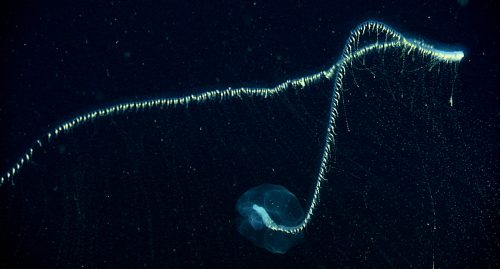Exploring the unique development of siphonophores
As far as gelatinous predators go, the Portuguese Man of War is well known, particularly to frequent beach-goers. Its long tentacles, which produce a painful sting upon contact with its prey, make it a formidable opponent at the ocean’s surface. While often mistaken for a jellyfish, the Portuguese Man of War is actually a siphonophore, a unique group of cnidarians, whose evolutionary history has been elusive until recently.
At Yale’s Dunn Lab, led by ecology and evolutionary biology professor Casey Dunn, researchers have been working to better understand the phylogeny or evolutionary history of siphonophores. Siphonophores are a fascinating order to study because of their unique characteristic as colonial animals: while a single siphonophore may appear as one animal, it is, in fact, composed of many functionally specialized organisms, known as zooids, that each play an important role in its survival. Some zooids are responsible for feeding, others for reproducing or swimming. During the sexual phase of a siphonophore life cycle, a single fertilized egg develops into the first zooid. One or two growth zones then sprout, allowing for the asexual budding of subsequent zooids, which remain attached.
To elucidate the poorly understood phylogeny and explore the unique development of siphonophores, the team collected various species from ocean ecosystems across the world. Because siphonophores are extremely fragile, the researchers relied on multiple collection methods, including blue water scuba diving and the use of remotely operated underwater vehicles. Some specimens were also collected through the process of upwelling, in which deep water containing the organisms was brought up to shallow levels. The team then extracted all of the mRNA from the collected specimens, which represents all of the active genes in the specimens. The mRNA lsof the thirty siphonophore species allowed them to use the genetic data to reconstruct a new phylogeny.
Historically, siphonophores have been categorized into three groups: Cystonectae, Physonectae, and Calycophorae. In 2005, Dunn constructed a different phylogeny based on two siphonophore genes. His proposed family tree suggested the reordering of siphonophores into two groups: Cystonectae and Codonophora, which combined the Physonectae and Calycophorae.
The current study, which now involves 1,071 genes, provides new data corroborating the phylogeny delineated by Dunn and also proposes new divisions. For instance, the researchers found strong evidence for Apolemiidae as a sister to all other codonophorans and Pyrostephidae as a sister to all other non-Apolemiidae codonophorans.
Furthermore, the results offer a new understanding of the evolution of certain siphonophore traits. Previous studies suggested that the common ancestor of siphonophores was dioecious: the male and female reproductive organs are located in different colonies. Monoecy, the trait in which the male and female reproductive organs are located in the same colony, was hypothesized to have evolved only once within the Codonophora. However, the current phylogeny provides evidence that two independent clades of siphonophores, Calycophorae and Clade A, both exhibit monoecy, suggesting that monoecy evolved twice. “This is an exciting evolutionary case of something occurring convergently more than once,” said Cat Munro, a graduate student on the preprinted paper.
Because zooids are so functionally diverse, scientists have had difficulty studying the evolution of different types. The reconstructed family tree, however, provides new data for scientists to explain the long-standing mystery of their origins. For example, bracts, zooids present only in Codonophora, are responsible for protection and buoyancy. The new phylogeny suggests that when bracts were lost in certain clades; other zooids evolved to make up for lost functions.
This research is momentous for understanding siphonophore phylogeny and trait evolution. “With this latest paper, we are able to tease apart some deeper relationships between the species more easily because of improvements of technology and the amount of data that we have to work with. We were able to identify a new group that we weren’t able to identify before, and it has shifted how we think about how siphonophores have evolved,” said Munro.
However, a number of siphonophore traits have yet to be completely understood. Alex Damián Serrano, another graduate student in the Dunn Lab, is investigating the evolution of specialized parts of siphonophore tentacles and their relationship to siphonophore habitat and diet preferences, while Munro is currently looking at a large set of gene expression data from different species to better understand siphonophore functional specialization. With the reconstruction of this new phylogeny, scientists can explore siphonophores in pioneering ways that will allow them to further unravel the enigmas of this interesting evolutionary tale.

